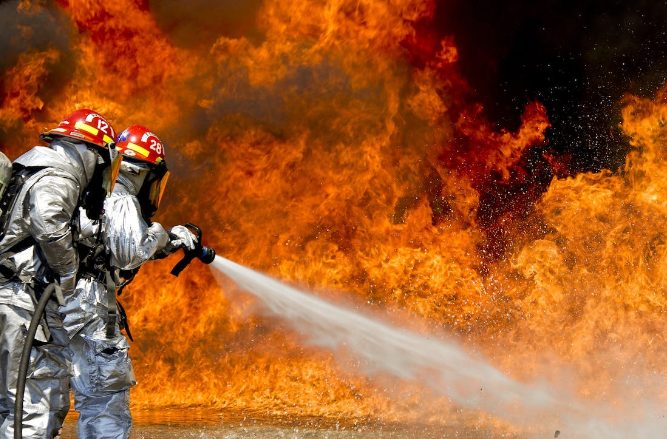Aqueous film-forming foam (AFFF) lawsuits have surged in recent years as individuals and communities seek justice for health complications linked to exposure. AFFF, widely used by civilian and military firefighters, contains per- and polyfluoroalkyl substances (PFAS) associated with severe health risks, including cancer.
In this guide, we navigate the landscape of AFFF personal injury claims, shedding light on legal avenues, ongoing litigations, and potential settlements.
Understanding AFFF and Health Risks
AFFF stands as a critical firefighting tool, extensively employed to combat flammable liquid fires. However, beneath its utility lies a significant concern – the presence of per- and polyfluoroalkyl substances (PFAS). These “forever chemicals” have raised alarms due to their persistence in the environment and documented health risks.
Studies have associated PFAS exposure with a spectrum of health complications, including bladder cancer, cholesterol changes, immune system damage, kidney cancer, and thyroid disease. Medical News Today also notes that those exposed to PFAS compounds are at a 56% higher risk of thyroid cancer.
As a result, individuals exposed to AFFF, including firefighters and military personnel, find themselves grappling with the potentially life-altering consequences of these toxic substances.
Initiating AFFF Personal Injury Claims
Initiating a personal injury claim related to AFFF exposure requires a nuanced understanding of eligibility criteria and legal processes. Those eligible to file claims include firefighters, military personnel, airport workers, oil rig workers, and individuals residing near facilities utilizing AFFF.
The process involves gathering evidence of exposure, medical records linking health conditions to AFFF, and establishing liability against manufacturers and other entities.
According to TorHoerman Law, legal representation plays a pivotal role in navigating the complexities of the claim process. It ensures that claimants have the best chance of obtaining compensation for their suffering.
From filing the initial complaint to participating in discovery and potential trial proceedings, the journey demands careful consideration and expertise.
Current State of the AFFF Litigation
The legal landscape for Aqueous Film Forming Foam (AFFF) is dynamic. The U.S. District Court for the District of South Carolina is overseeing a multidistrict litigation (MDL), which includes thousands of pending AFFF cases.
ConsumerNotice.org notes that as of February 2024, a total of 7,191 AFFF lawsuits have been filed in the MDL. 6,994 of these lawsuits are pending. These cases involve individuals and water supply companies seeking compensation for health damages and water contamination.
The sheer volume of lawsuits highlights the widespread impact of AFFF and the urgency for legal resolution. The court proceedings involve selecting cases for bellwether trials, allowing both plaintiffs and defendants to gauge potential outcomes. Bellwether trials also pave the way for a more efficient resolution of subsequent claims.
Entities and Manufacturers Involved
Prominent manufacturers, including 3M, DuPont, and Kidde-Fenwal, find themselves at the center of AFFF lawsuits. These companies face allegations that they were aware of the risks associated with PFAS in the foam but failed to adequately warn the public.
Additionally, the National Fire Protection Association is implicated for its role in creating firefighting equipment testing standards that allegedly necessitated the use of PFAS. The involvement of various entities adds layers to the legal complexities surrounding AFFF litigation.
This makes it crucial to explore manufacturers’ responsibilities in addition to the standards set within the firefighting industry.
AFFF Lawsuit Settlements
Amidst the multitude of AFFF lawsuits, settlements have emerged as potential avenues for resolution. The New York Times notes that in June 2023, foam manufacturer 3M proposed a substantial $10.3 billion settlement to address thousands of claims. The company also claims to shut down all PFAS manufacturing by 2025.
While firefighter foam cash settlements may accelerate resolution, they also prompt concerns about compensation adequacy and manufacturer accountability. Claimants face the crucial decision of whether to accept settlement offers or pursue individual lawsuits.
The dynamics of settlements in AFFF lawsuits underscore the complexity of balancing justice for victims and the expeditious resolution of widespread litigation.
Regulatory Reforms and AFFF
As AFFF lawsuits unfold, the focus extends beyond individual claims to the broader landscape of regulatory reforms. This section delves into the ongoing efforts and potential changes in regulations governing the use of AFFF and PFAS. The growing awareness of the environmental and health hazards associated with AFFF has spurred discussions at both national and international levels.
Regulatory bodies are under increased scrutiny, with calls for stricter guidelines, transparent disclosures, and proactive measures to minimize the risks posed by firefighting foams. Legislative initiatives aimed at restricting the use of PFAS in various applications, including firefighting, are gaining momentum.
The intersection of legal actions, public awareness, and regulatory reforms contributes to shaping the future of AFFF litigation. Stakeholder advocacy for safer alternatives and responsible practices is expected to shape the firefighting industry’s approach, addressing environmental and health impacts linked to AFFF.
In conclusion, the surge in AFFF personal injury claims highlights the urgent need for justice amid documented health risks linked to PFAS exposure. With thousands of lawsuits and notable settlements, the complex legal landscape underscores the widespread impact.
Manufacturers, industry standards, and regulatory bodies face scrutiny, emphasizing the multifaceted nature of AFFF litigation. As the legal battles unfold, the interplay between individual claims, regulatory reforms, and stakeholder advocacy will shape the future.
This emphasizes the necessity for a comprehensive approach to address the environmental and health consequences of AFFF. The resolution of these cases carries implications not only for affected individuals but also for industry practices and public safety.

Aretha Davis, the wordsmith extraordinaire, weaves enchanting tales with her pen and keyboard. A renowned blogger and writer, her captivating prose transports readers to realms unknown. Join her literary journey and be swept away by the magic of her words.
